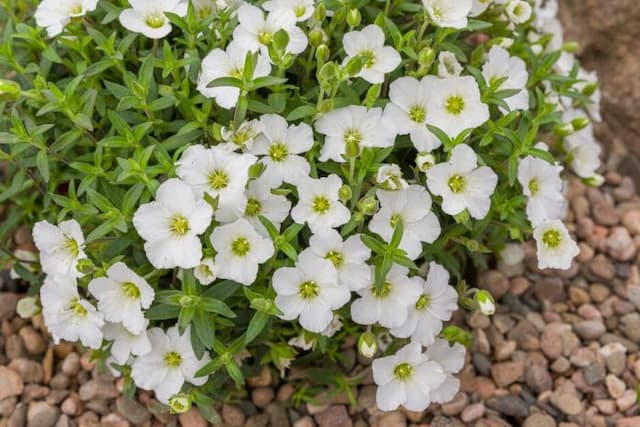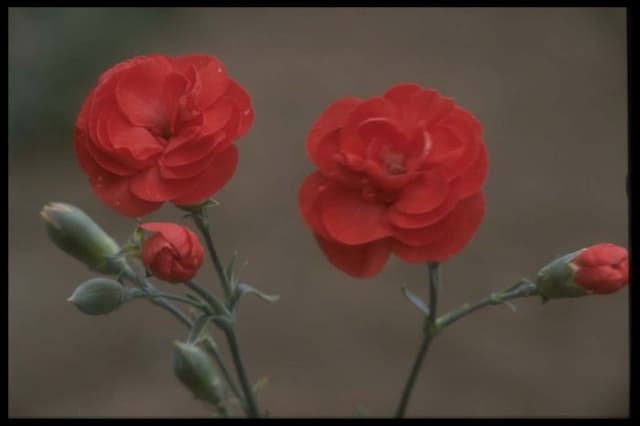Sweet William Dianthus Lady in Red = 'Wp04 Xanthe' (PBR) (p)
![pink [Lady in Red]](/_next/image?url=https%3A%2F%2Fplants-admin.emdemapps.com%2Fimages%2Fplants%2F%2Fimages%2F604b536118270.png&w=3840&q=75)
ABOUT
The Dianthus Lady in Red, also known as ‘Wp04 Xanthe,’ is an alluring perennial with a striking appearance. This plant features dense mounds of slender, blue-green foliage that provide a contrasting backdrop to its vibrant flowers. It produces an abundance of rich red blooms which create a bold and dramatic display. Each flower is typically marked with a unique pattern of deep red tones and possesses a frilled edge that adds to its ornamental charm. The blossoms are radiant and are known to attract pollinators with their eye-catching color and sweet fragrance. The overall visual effect of the Dianthus Lady in Red is of a lush, colorful tuft of greenery interspersed with the brilliant red of the flowers that can catch the eye and become a focal point in any garden setting.
About this plant
 Names
NamesFamily
Caryophyllaceae.
Synonyms
Lady in Red Carnation, Lady in Red Pinks.
Common names
Dianthus 'Wp04 Xanthe' (PBR) (p)
 Toxicity
ToxicityTo humans
The plant commonly known as Sweet William is generally not considered toxic to humans. There are no significant reports of poisoning or toxic effects from ingesting this plant. However, as with many plants, individual sensitivities can vary, and it's always prudent to avoid ingesting parts of ornamental plants due to the potential for unknown allergic reactions or gastrointestinal discomfort.
 Characteristics
CharacteristicsLife cycle
Perennials
Foliage type
Evergreen
Color of leaves
Blue-green
Flower color
Red
Height
1 foot (30 centimeters)
Spread
1 foot (30 centimeters)
Plant type
Herb
Hardiness zones
Varies
Native area
Europe
Benefits
 General Benefits
General Benefits- Easy to Grow - The Dianthus 'Lady in Red' is known for its hardiness and ability to thrive in a variety of conditions, making it suitable for gardeners of all skill levels.
- Long Flowering Season - With its prolonged blooming period, it provides color and vibrancy to gardens for an extended time from late spring to early fall.
- Attracts Pollinators - Its brightly colored flowers are attractive to bees and butterflies, which are essential for pollination in the garden.
- Drought Resistance - Once established, this plant exhibits good drought tolerance, requiring minimal watering in dry conditions.
- Low Maintenance - It needs minimal care beyond the occasional watering and trimming to keep its shape and encourage further blooms.
- Compact Size - Its compact growth habit makes it perfect for small gardens, borders, and containers, allowing for versatile garden design options.
- Cut Flowers - The blooms can be used for bouquets and arrangements, providing a fresh, fragrant addition to the home.
- Colorful Blooms - The ‘Lady in Red’ features vibrant red flowers, adding a bold splash of color that can brighten any garden space.
- Fragrant - The flowers emit a pleasant fragrance, which can be a delightful addition to the garden or when used as cut flowers indoors.
- Cold Hardy - It is able to withstand cooler temperatures, making it a robust choice for gardens in temperate zones.
 Medical Properties
Medical PropertiesThis plant is not used for medical purposes.
 Air-purifying Qualities
Air-purifying QualitiesThis plant is not specifically known for air purifying qualities.
 Other Uses
Other Uses- Dianthus Lady in Red can be used as an all-natural dye for fabrics, giving textiles a soft pink to red hue depending on the preparation and concentration.
- The petals of the Dianthus can be crystallized and used as edible decorations on cakes and desserts, adding a fancy and colorful touch to culinary creations.
- Dried Dianthus petals can be incorporated into homemade potpourri mixes for a fragrant addition to any room.
- The vivid colors of the plant make it an excellent candidate for pressing and using in scrapbooking or other paper-based crafts.
- Some artists use the crushed petals of Dianthus Lady in Red in their watercolor paint mixtures to create unique, organic shades.
- Dianthus can also serve as inspiration for fragrances; though not extracted directly, its scent can guide perfumers in crafting floral-themed perfumes.
- The plant's flowers can be used to embellish cocktails or ice cubes, adding a touch of elegance to refreshments served at special events.
- Pressed and framed Dianthus blossoms make beautiful, natural artwork for home decoration that brings a bit of the garden indoors.
- Gardeners may use the dense growth habit of Dianthus Lady in Red as a living mulch to suppress weeds around other plants.
- Bio coloring agent for crafts, such as naturally colored playdough for children, offers both a pleasant scent and a teaching moment about plant-based colors.
Interesting Facts
 Feng Shui
Feng ShuiThe Carnation is not used in Feng Shui practice.
 Zodiac Sign Compitability
Zodiac Sign CompitabilityThe Carnation is not used in astrology practice.
 Plant Symbolism
Plant Symbolism- Love and Admiration: The red color of 'Wp04 Xanthe' carnations is often associated with deep love and admiration, making it a popular choice for romantic occasions.
- Distinction and Fascination: Carnations are symbolic of fascination and distinction, which could be attributed to their unique and intricate petal structure.
- Mother's Love: Carnations have a historical association with a mother's undying love, and red carnations amplify this sentiment, perhaps due to their vibrant and passionate hue.
- Good Luck: In some cultures, carnations are given as a token of good luck, especially red ones that are said to symbolize good fortune and favor.
 Water
WaterSweet William, known scientifically as Dianthus 'Wp04 Xanthe', requires moderate watering. It should be given enough water to keep the soil moist but not soggy. Allow the top inch of soil to dry out before watering again. Typically, this equates to watering once a week, but this can vary depending on climate and weather conditions. For an average-sized plant, using approximately one gallon of water every week during the active growing season should suffice. Adjustments should be made during the dormant season or periods of rainfall to prevent overwatering.
 Light
LightSweet William thrives best in full sunlight to partial shade. Ideally, it should receive at least six hours of direct sunlight daily. A spot that provides morning sunlight and afternoon shade would be ideal, as the intense heat of the afternoon sun could be too stressful for the plant.
 Temperature
TemperatureSweet William is comfortable in a wide range of temperatures but performs best when daytime temperatures hover around 60-70 degrees Fahrenheit. While it can withstand light frosts, it should be protected or brought indoors if temperatures are expected to dip below 40 degrees Fahrenheit. At the other end of the spectrum, the plant may struggle if exposed to temperatures consistently above 85 degrees Fahrenheit.
 Pruning
PruningPruning Sweet William is important to promote vigorous growth and to maintain a tidy appearance. Deadhead faded flowers regularly to encourage more blooms. After the main blooming period, cut back the stems to about half their height to potentially stimulate a second bloom. The best time to do a major pruning is immediately after the plant finishes its main flowering cycle.
 Cleaning
CleaningAs needed
 Soil
SoilSweet William prefers well-draining soil with a neutral to slightly alkaline pH, typically around 6.7 to 7.5. A good mix is one part garden soil, one part compost, and one part perlite or coarse sand to ensure proper drainage.
 Repotting
RepottingSweet William does not require frequent repotting and can thrive in the same pot for several years. It may be repotted once it outgrows its current container or every two to three years to refresh the soil.
 Humidity & Misting
Humidity & MistingSweet William prefers average room humidity and does not require high humidity levels. Ensure good air circulation around the plant to prevent disease.
 Suitable locations
Suitable locationsIndoor
Place Sweet William near a sunny window and water sparingly.
Outdoor
Plant in full sun to partial shade, in well-drained soil.
Hardiness zone
3-9 USDA
 Life cycle
Life cycleDianthus 'Lady in Red', also commonly known as Sweet William, begins its life cycle as a seed which, when sown and given appropriate conditions, will germinate and sprout. The seedling stage is characterized by the emergence of a pair of true leaves, which will further develop into a rosette form as the plant enters the vegetative stage. Here, the plant focuses its energy on leaf and stem growth, establishing a strong root system. Subsequently, the reproductive stage is marked by the development of flower stems and the blooming of vibrant red flowers, often in late spring to early summer. After pollination, the flowers produce seeds, completing the reproductive cycle. Finally, depending upon the climate, Dianthus 'Lady in Red' can act as an annual, biennial, or short-lived perennial, with the plant eventually senescing and dying, leaving seeds to begin the next generation.
 Propogation
PropogationPropogation time
Spring to Summer
Propogation: The Sweet William, known botanically as Dianthus 'Lady in Red' = 'Wp04 Xanthe' (PBR) (p), is commonly propagated through stem cuttings, a method that offers a reliable means of maintaining the parent plant's characteristics. The optimal time for taking stem cuttings is late spring to early summer when the plant's growth is most vigorous. To propagate Sweet William by stem cuttings, one should select a healthy, non-flowering stem and make a cut to obtain a segment about 3 to 5 inches long (approximately 7.5 to 12.5 centimeters). Remove the lower leaves and dip the cut end in rooting hormone powder to enhance the chances of success. The cutting should then be planted in a mix of peat and perlite and kept under conditions of high humidity, at a temperature of about 70 degrees Fahrenheit (21 degrees Celsius), till it has rooted, typically in a few weeks. Once established, the young plants can be transplanted to their final location in the garden.


![Pink [Tequila Sunrise]](/_next/image?url=https%3A%2F%2Fplants-admin.emdemapps.com%2Fimages%2Fplants%2F%2Fimages%2F604b5d995d06e.png&w=640&q=75)






